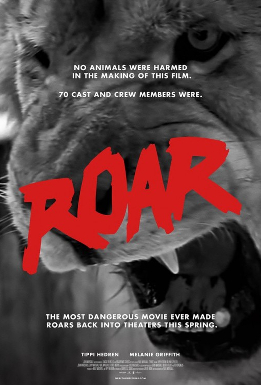Originally released in 1981, Drafthouse Films has resurrected Noel Marshall's highly controversial Roar, giving it the marketing exposure that it rightfully deserves. Touted as the most dangerous movie ever made, the film prides itself on its ability to use the American Humane Association seal disclaimer"¦but audiences should quickly take note that no seal is present representing the absence of human injury.
Following wildlife preservationist Hank as he lives with a collection of over 100 untamed animals, Roar is a unique film that was inspired by writer/director Noel Marshall and his then-wife Tippi Hedren's love for cats. The journey took eleven years to complete and is a family affair, starring their three kids. While audiences never lined up to watch the actors flirt with death, the end result is a cult spectacle that must be seen to be fully appreciated.
The story itself is fairly simple. Hank is living in a home overtaken by animals, working to thwart those wishing to kill the precious beasts by proving that they can live harmoniously with humans. He has invited his family out to take part in the project, a decision that he soon regrets as he finds himself away from home when they arrive.
Roar never designates itself as a comedy or a horrific thriller - and audience shouldn't care. No one is venturing into the theater to see a low-budget classic. Instead, they are hoping to witness something unusual, working hard to decipher which takes might have resulted in one of the over seventy on-set injuries.
The film progresses with a series of bad luck surrounding Hank's family as they work to navigate towards safety. From locking oneself in an ice cooler to a rather entertaining chase sequence through the house, the foursome couldn't quite figure things out. And while the cat-and-mouse chase is humorous (and occasionally intense), it gets a bit tiresome about half way in. As a result, the film runs its course in that amount of time, leaving us twiddling our thumbs and awaiting an unexpected attack.
The film ends just as abruptly as it begins, without really resolving much and forgoing its central story arc of just how this family is expected to live with its untamed housemates. There are stills just before the credits that showcase the aftermath, but there are generate more questions than answers, forcing viewers to squander all sense of realism and accept the film for what it truly is - a thrilling experience that benefits greatly from what the Drafthouse Films has made of it.
I recommend Roar. Not for its story or any of its film like qualities but rather its absurdity and notoriety. Roar wasn't much in 1981, and the film itself hasn't gotten any better. However, the viewing experience is easily worth the price of admission.

